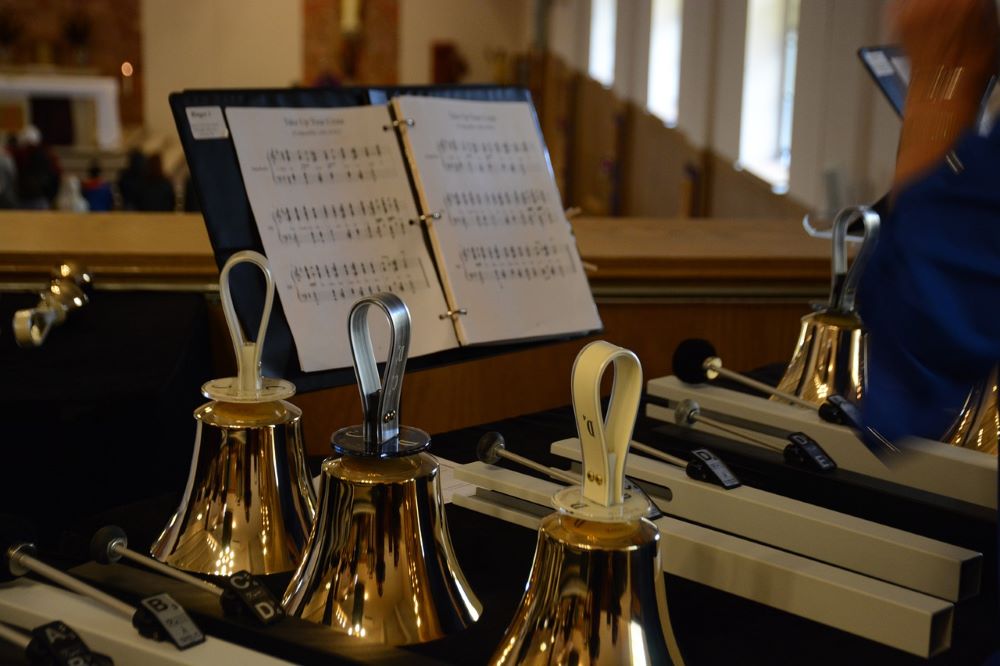
(Pixabay/Jennifer Webb)
Despite the assumption that every church music director knows how to direct a hand bell choir, I have evidence that this is erroneous, and I am living to tell the tale.
A few years ago, I not only inherited a parish that was the largest in the diocese, but also inherited three large, heavy, black and mysterious cases lying forebodingly on the table in the music room. The pastor had mentioned, enthusiastically, something about "hand bells." There had been a very good hand bell choir consisting of high school seniors, but all the students had graduated. It was clear to me that the pastor had great expectations about hand bells.
Not only did I not know what to expect when I opened the cases, I also did not know how to get hand bell choir members.
Slowly, I opened the largest case, with the name "Malmark" engraved on the front. A big brass bell glared at me, as if it were resentful of having been awakened. Other brass bells, of varying dimensions, were also silently defiant. "Ring my bell," each seemed to sneer. Somehow, I could tell they knew of my ignorance.
I opened the other cases, each with similar bells, all in different sizes. Twenty-four bells in total. "Get a book! Get a book!" my frantic mind thought. If I had a book, I could read it and find out how to be a hand bell director!
Handbook for Hand Bells, it read. Twenty-four bells: Check. How to hold the hand bell: Check. How to ring the hand bell (My interpretation: Take the biggest bell.) Move your arm outward: Check. Flick your wrist: wrong move. Do not ring the bell next to your ear.
Advertisement
In the next chapter, I managed to dig up some music for the hand bell ringers. All the music I found was for the advanced group of the previous year. I groaned. I could hardly understand how the music was arranged.
I wrote up an advertisement for the Sunday bulletin, hoping a group of seasoned hand bell ringers would volunteer and make my life easier. Everything else in the realm of church music responsibilities was taking a back seat to this hand bell program: the adult choir, the funeral choir, the wedding music, the cantors.
The practice was scheduled for Saturday afternoon. I laid the bells on the long tables, put the music on stands, and laid gloves at each place.
Timidly, eight children, aged 9 and 10, appeared in the doorway. I'm sure they would have preferred to be playing ball or popular music. Still, they were here and fully attentive to my instructions. I was going to have to alter some of my plans. Each looked quizzically at me when I talked about the music on the paper and what bell to play when what note appeared. We were all going to learn how to play bells from ground zero, together.
For the two years that I spent at the parish, I thoroughly enjoyed working with these children! They began by playing more by colored signals on their music sheets than by playing notes. They sounded great! Their steadfast eagerness to play the hand bells made them a welcome addition to Masses. They were even invited to play for an ecumenical service.
Years passed, and I was then appointed music director at our motherhouse.
A major celebration was coming up, and I wanted the Mass to be extra special.
A moment of inspiration led me to borrow the hand bells from the parish I had worked in. The sisters were absolutely excited about this new experience!
Perched in the sanctuary of the chapel, situated around a card table, they played heartily. One sister came by after the Mass and complimented the group, saying they should be called the "Quasimodo Ringers"!
A sister managed to continue the hand bell program for the sisters — including the senior sisters! They included some secular pieces in their repertoire and entertained the rest of the motherhouse sisters.
Today, as I once again have the responsibility of being music director at our Motherhouse, we have a two-octave set of hand bells, with only five ringers to handle them. They are phenomenal, considering that some must handle three or four bells in one musical piece! Often, I am the piano accompanist and play synthesized "bells" that our limited group cannot play. I cannot always appreciate the efforts of the bell ringers, but they are very encouraged by the compliments of the sisters.
I must always trust that they are using the correct bells. Normal bell choirs have enough players who are assigned the same bells. This choir doesn't have enough players, and it takes a little while for them to exchange bells before the actual performance of a piece. One time, a player was missing a bell because I assumed that everyone had her bells ready. I started the introduction, and the poor sister smiled bravely as she played only the bells she had. Mozart's "Ave verum corpus" certainly had a unique sound! Hurray for the "Quasimodo Quintet"!







